ภูมิปัญญาท้องถิ่นในการอนุรักษ์ความหลากหลายทางชีวภาพของเห็ดในป่าชุมชนโคกใหญ่ เพื่อการใช้ประโยชน์อย่างยั่งยืน
Keywords:
Local Wisdom, Conservation, BiodiversityAbstract
The purposes of this research were to study local wisdom involving natural mushrooms in these following aspects; occurring place of mushrooms, how to investigate kinds origins of mushroom and conservation of mushrooms. The sampling group were 75 people who live in the surrounding area of Khok Yai Community Forest. The sampling group were classified into 2 groups; 5 people for leaders in mushrooms seeker and 70 people for the experts about mushroom. The study period was between October 2012-September 2013. The instruments used in this study were a structured interview form and a participant observation form. The data were analyzed by using the qualitative research methodology and the results were presented by percentage of a descriptive analysis. In this survey, 46 kinds of mushrooms were found in Khok Yai Community Forest . The occurring place of mushrooms in KhokYai Community Forest were categorized of 5 characteristics ; first, the emergence in an open area such as Tha and Tad mushroom ( Diminutive Agaricus), Tapoo mushroom (Calvatia cranifoomis Coker et Couch),Tapu mushroom (Calvatia boninensis), second, the emergence of mushroom on stump and timber long such as, Kradang mushroom (Lentinus polychrous Lev.), Khon Khaw mushroom (Lentinus squarrosulas Mont.), Hunoo mushroom( Auricularia auricula Judae), Phek mushroom ( Lentinus strigoeue ( Schw ) Fr.), third, the emergence of mushroom under the earth surface such as Poh Nang mushroom (Geastrum saccatum Fr.), Poh Fai mushroom Astraeus hygrometricus (Pers.) Morgan), Talo mushrooms (Calostoma lutescens), fourth, the emergence of mushroom in the anthill area such as different kinds of Pluak khaw mushroom (Calvatia boninensis), PluakJik (Termitomyces microcarpus (Berk.et Broome)Heim), PluakNoi (Termitomyces microcarpus) and fifth, the emergence under tree-shadow area and under falled-leaves on soil such as La-ngok yellow mushroom ( Amanita hemibapha (Berk. Et Broome) Sacc subspjavanica Corneret Bas) เห็ดไคเห็ดหน้าแหล่ เห็ดผึ้ง, Khai mushroom (Russula delica Fr.) ,Na-lae mushroom ( Russula cyanoxantha Schaeff.ex Fr.), Phueng mushroom (Heimiell retispora (Pat, and Bak.)). From the villagers' observations on natural signals indicating that mushrooms would emerge when there was dispersed clouds, high humid weather for 3-4 days after the rain, feel sweated on the nose, etc. Furthermore, conservation of mushroom and occurring of the mushrooms are folk wisdom of the villagers living around the Khok Yai Community forest area. The wisdom for harvesting transferred to new generation for raise awareness of love and protection of forest and the mushrooms. They were taught not to pick small and old mushrooms and let the leaves covered soil surface after gathering the mushrooms. Moreover, they would leave some part of the mushrooms in the forest area to keep expanding the mushrooms in the future. In the other words, the villagers had clever manipulation in mushroom forest conservation through some local ceremony such as tree ordinations, Pha Pa Ton Mai and Suep Chata Pa. Khok Yai Community Forest is an important for food supplier. Further more, The mushroom found in this forest are critical to the livelihoods of the people in the area. Local wisdom is also importance to maintain forest conservation and effect to mushroom biodiversity.
References
เทียมหทัย ชูพันธ์ . (2548). ความหลากหลายของชนิดพันธุ์พืชและพฤกษศาสตร์พื้นบ้านของป่าโคกศรี อำเภอเชียงยืน จังหวัดมหาสารคาม. วิทยานิพันธ วท.ม. มหาสารคาม : มหาวิทยาลัยมหาสารคาม.
น้องนิจ เหลื่อมล้ำ และชริดา ปุกหุต. (2546). ความหลากหลายทางชีวภาพของเห็ดป่าในอุทยานแห่งชาติ ภูจองนาย่อย : 1. เห็ดไทย 2546 : สมาคมนักวิจัยและเพาะเห็ดแห่งประเทศไทย.
ราชบัณฑิตสถาน. (2539). พจนานุกรมฉบับราชบัณฑิตยสถาน พ.ศ. 2525 . กรุงเทพมหานคร : อักษรเจริญทัศน์ อจท. จำกัด.
ราชบัณฑิตยสถาน.(2539). เห็ดกินได้และเห็ดพิษในประเทศไทย.ฉบับราชบัณฑิตยสถาน. กรุงเทพมหานคร.
ศิริวรรณ สุทธจิตต์ และไมตรี สุทธจิตต์ . (2545). เห็ดสมุนไพร :จากอดีตสู่ปัจจบุันและอนาคต นานาสารพัดเห็ด. มูลนิธิสวิตา ศูนย์ความหลากหลายทางชีวภาพและสมาคมนักวิจัยและเพาะเห็ดแห่งประเทศไทย.
สมหญิง บู่แก้ว. (2552). การประเมินมูลค่าการใช้ประโยชน์ผลผลิตจากป่าที่ไม่ใช่เนื้อไม้ จากป่าชุมชนโคกใหญ่อำเภอวาปีปทุม จังหวัดมหาสารคาม. วิทยานิพันธ วท.ม. มหาสารคาม : มหาวิทยาลัยมหาสารคาม.
สถาบันวิจัยวลัยรุกขเวช. (2545). การศึกษาการใช้ประโยชน์จากป่าวัฒนธรรมอย่างยั่งยืน ชุดโครงการการจัดการทรัพยากรอีสานโดยใช้ภูมิปัญญาพื้นบ้านเป็นฐานในการพัฒนา. มหาสารคาม : มหาวิทยาลัยมหาสารคาม.
สำนักนโยบายและแผแผนทรัพยากรรมชาติและสิ่งแวดลอม. (2550). รายงานโลกทรรศน์ความหลากหลาย ทางชีวภาพฉบับที่ 2. กรุงเทพฯ :กระทรวงทรัพยากรธรรมชาติและสิ่งแวดลอม.
สำนักงานความหลากหลายทางชีวภาพด้านป่าไม้. (2553). ความหลากหลายทางชีวภาพในพื้นที่ป่าชุมชน ตำบล หนองเหล่า อำเภอเขื่องใน จังหวัดอุบลราชธานี. กลุ่มงานความหลากหลายทางชีวภาพด้านุปาไม.้ กรมุปาไม้. กรุงเทพฯ : กระทรวงเกษตรและสหกรณ์ .
Downloads
Published
How to Cite
Issue
Section
License
Articles that are published are copyrighted by the authors of the articles







